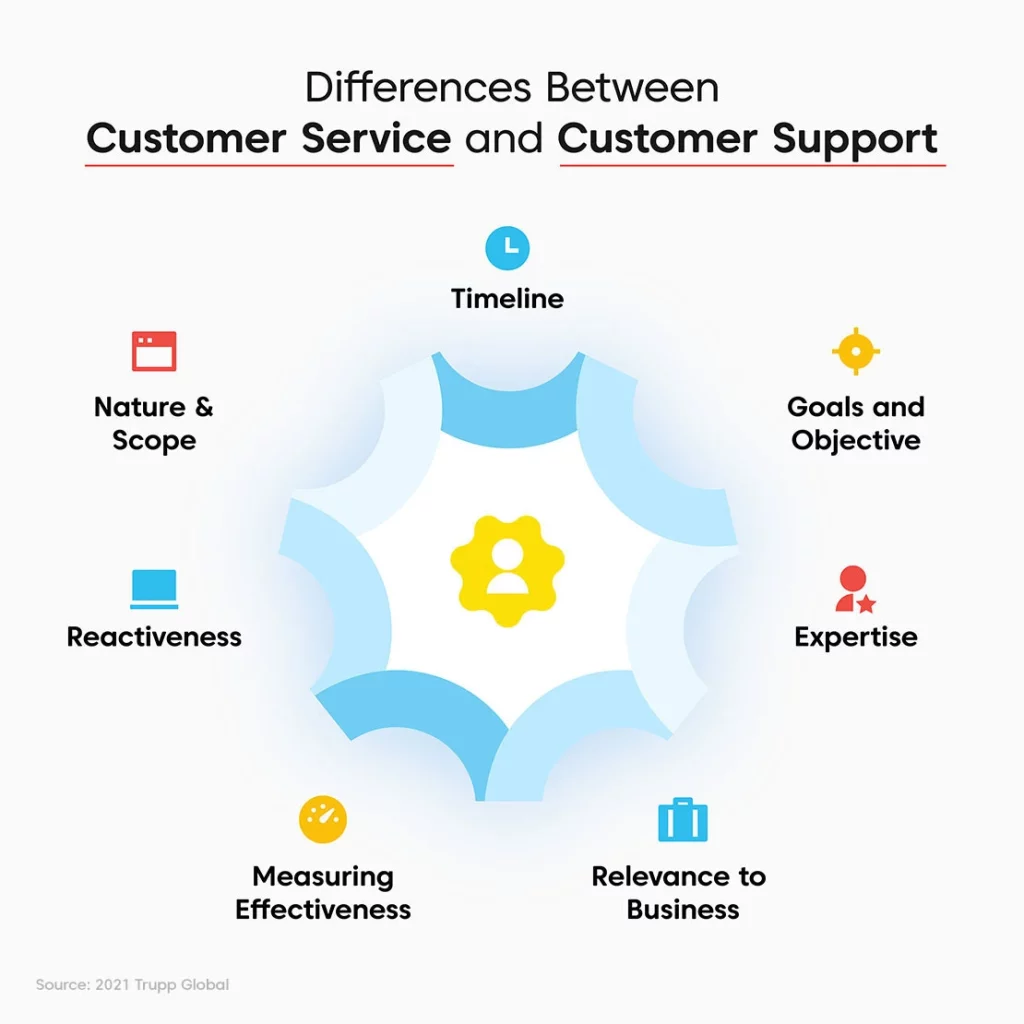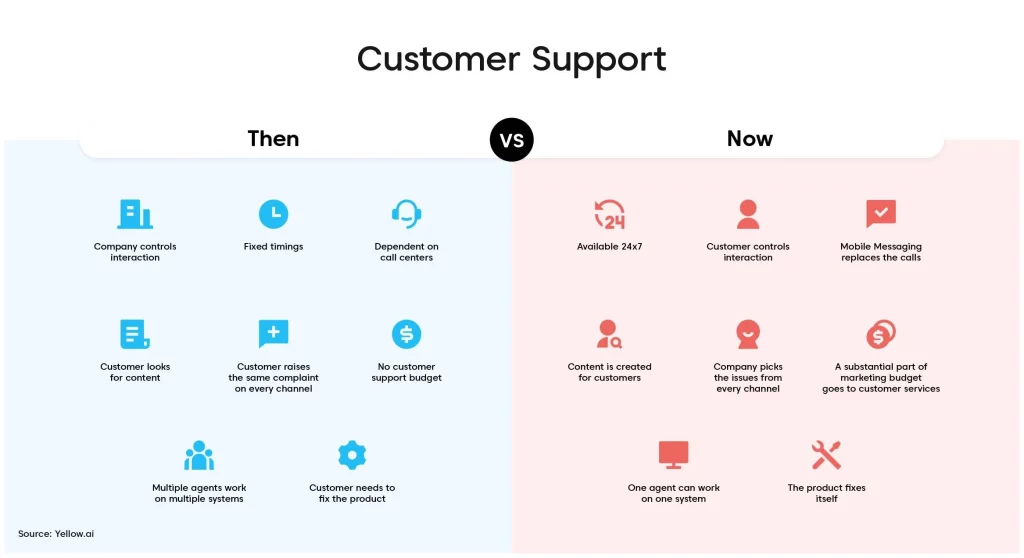What is Customer Support?
Customer support is a part of the customer service umbrella that gives precedence to customers experiencing trouble or who need help with a product or service. The teams handling customer support offer technical assistance or respond to customers’ requests about their product or service. The objective of a customer support team is to make sure customers leave their conversations with the right answers or a constructive experience.
For example, chatbots are one of the popular AI tools used in customer support. Companies today use chatbots of varying complexity to manage everyday queries regarding balance owed, delivery dates, and order status among others. By shifting these queries to a chatbot, the customer support team can serve more people and build an enhanced experience while reducing operational costs. At Yellow.ai, we help businesses engage with customers wherever they are, through conversational virtual assistants, across text and voice for lasting loyalty.
A History of Customer Support
As believed incorrectly by many, customer support is not a modern concept. In its conventional sense, it goes all the way back to the age when humans began trading. Fulfilling customers’ needs and serving them better than others to foster loyalty was and continues to be the foundation of customer support. Over time, providing customer support has changed, as have buyers’ expectations of what forms excellent support.
Until the end of the nineteenth century, customer support was restricted to the exchanges between buyers and sellers. Customer support kept evolving with the introduction of modern tools such as telephones that led to the inception of call centres in the 1960s, email in the 1990s, social media and CRMs in the 2000s, to today’s vibrant tech-powered customer support helpdesks.
Today, support is centred around the customer. Using modern developments in technology, companies are doing all they can to continually delight customers and make sure they fulfil customers anywhere they want. Today, we are in the era of proactive customer support where merely satisfying customers’ expectations is not enough. Consequently, at Yellow.ai, we automate & personalize customer support so your customers are not kept waiting for a resolution.
Role of Customer Support
The most important task of a support team is to deal with customer concerns and resolve them promptly. Customer support representatives interact with customers on various channels and ensure that all legitimate customer concerns are dealt with instantly.
Why is Customer Support Important for Your Business?
Excellent customer support is key to running a successful business and is indispensable because of the following reasons:
- Promotes word-of-mouth marketing
- Makes it easier for customers to do business
- Sets you apart from your rivals
- Builds customer loyalty
- Adds value to your brand
- Enhances employee morale and lowers turnover costs
- Results in the creation of a positive brand image
- Boosts customer retention and recurring revenue
- Adds value to a product or service
Difference Between Customer Support vs Customer Service
Customer service is a larger term for all interactions that bolster customer support experience and enhance their association with the firm. All companies offer customer service, but not all may offer support. The distinction between customer support and customer service is that a support team can correct a technical problem but delivering great customer service facilitates the nurturing of relationships and forms a true collaboration. If customer support is the how of resolving a problem, customer service is the why. Adding the “why” into the support process enhances customer experience and helps customer support agents flourish.

| Customer Service | Customer Support |
| A term for all chats that improve customer experience and boost their relationship with the firm | A single form of interaction |
| Builds relationships | Resolves technical issues |
| Focuses on enabling, useful customer transactions | Focuses on enhancing the intersection between the product and customer experience |
| Implies proactive interaction and consists of a business guiding the customer throughout the whole journey | Implies responding reactively to a customer’s query whenever a customer has a problem with the product/ service |
| Involves entry-level work with limited opportunities to grow | Several different prospects available to expand your abilities in addition to management |
| Often measures transactional metrics such as average handle time, ]first contact resolution, and CSAT | Besides transactional metrics, also it also takes into consideration business-related metrics such as Customer Effort Score, churn, and Net Promoter Score, |
| Positions are available in all industries that serve customers | Positions are often limited to SaaS and e-commerce businesses |
| Customer-centric | Business-centric |
| The why | The how |
What is an Example of Good Customer Support?
Good customer support involves fulfilling customers’ expectations in a pleasing, timely, and efficient way. Some of the key ingredients include:
- Offering a quick reply when customers get in touch with a problem, and demonstrating to them that their concerns are valued.
- Empathizing with customers to show them you recognize their viewpoint and accept them.
- Giving self-service options to customers, helping them find solutions to their concerns.
- Simplifying customer service across different channels such as social media, website, email, and phone to make the service convenient.
- Going beyond customer expectations to deliver a positive experience and promote customer loyalty.
- Serving many customers simultaneously when there is a surge in visitors without compromising on the quality of each conversation.
For example, rewarding repeat customers is a perfect example of good customer support. With POS software, businesses can track the activities of repeat customers, and synchronize data by offering them personalized shopping experiences. By adding loyalty points to such software, businesses can reward customers for shopping with you both in-store and online.

What are the Most Common Customer Support Issues/Challenges?
Some of the most prevalent customer support issues/challenges are as follows:
- Not knowing the answer to a question: There will be instances when customers will have questions that agents simply cannot answer immediately. However, through intelligent digital assistants or agents, it is possible to direct customers to a knowledge base where they can get their questions answered.
- Transferring customer calls: Transferring calls is annoying for customers and they often end up angry after spending time repeating their concerns many times over, and with several agents involved, it leads to more time being wasted awaiting incoming calls. To overcome this challenge, businesses can take the help of an agent assist dashboard that transfers all customer data to the concerned team member.
- Customer service workflows aren’t aligned with their journey: Without mapping out customer support workflows, problems can go unaddressed. And if customers run into several issues along their journey they could abandon things altogether. To resolve this challenge, smart digital assistants can be used since their performance stays consistent irrespective of how much work they do and always run at full capacity.
- No escalation protocol: Handling a crisis in the absence of a strategy could lead to turmoil. Irrespective of what a specific crisis involves, customer support will certainly be at the front line. The ideal thing to do is to be prepared as you are unsure when trouble may arise. Digital assistants make sure businesses are prepared to tackle such escalations and ensure quick resolution than conventional bots.
- Not fulfilling customer expectations: Customer expectations change constantly and to fulfill them you must understand who the customer is, the journey they take while interacting with a brand, and what it is they wish to have. To make sure brands have an omnichannel presence and are able to provide 24/7 support to the customers, digital assistants can be used.
- Inability to respond promptly: This can be overcome through email autoresponders and templates, setting time-based alerts and cataloging emails using keywords based on priority.
- Handling angry customers: The real test of a customer support team’s expertise is in how they manage difficult customers. The H.E.A.R.D framework that includes Hearing, Empathizing, Apologizing, Resolving and Diagnosing is one potent technique to overcome this challenge.
- Lack of personalization: Having a personal touch during customer interactions is always beneficial and its absence could potentially ruin the whole experience for the customer. This can be overcome by addressing customers by their first name, knowing them well, being receptive to their feedback and offering a tailored service experience.
- Managing a crisis: When a business encounters a crisis, the customer support team ends up getting pressurized. An easy way to overcome such a situation is to predict and be ready for it beforehand.

Types of Customer Support Channels
When customers approach the support team with their problems, the team has an opportunity to turn the experience of the customer around through quick and high-quality support. Here are some of the popular customer support channels that a firm must use separately or in combination with other channels:
Email: An inexpensive, simple, and potent tool that enables firms to manage support queries.
Social media: Many businesses today take full advantage of various social media platforms by building a personal rapport with customers on the channel.
Text messages: Online messaging offers asynchronous communication. Customers and agents can access a log of past conversations and keep the chat going over a longer period of time.
Knowledge base and FAQs: A key yet often under-used customer support tool is the firm’s self-service knowledge and resource base.
Voice: Many people still prefer chatting over the phone because of the human element. It allows them to clarify their complaints with transparency, and the agents to address them with patience and empathy.
Chat support: Live chat support is a popular support channel that offers the speed of phone support, without the possible uneasiness for those who prefer dealing with support agents online. Often a customer support chatbot is used by businesses worldwide to handle such customer complaints.Conversational bot support: From product tours to collecting feedback, conversational chatbots can take care of an end-to-end customer support experience that will boost your customer satisfaction score as well as customer retention rate.
Key Features of Customer Support
To enhance customer support interactions, a system must have the following features:
- Unified Agent Desktop
- Live Chat Support
- Smart Ticket Prioritization
- Robust Mobile App
- Omnichannel Communication Support
- Internal Chat Option
- Inbuilt Ticketing System
- Customer Sentiment Analysis
- Self-Service Portal
- Up-To-Date Knowledge Base
Customer Support Tools and Technologies
There is no ‘one-size-fits-all’ formula when it comes to customer support requirements as each business has its distinct needs. However, there are certain points that businesses must consider at the time of opting for a customer support tool:
- Effectiveness: How does the customer support tool address the challenges it’s supposed to solve? Is it a stand-alone, self-sufficient software, or does it require other tools?
- Usability: Is the customer support tool easy to set up? Is the tool potent and intuitive to use?
- Value: Does the tool deliver value for your money? Will the customer support tool benefit both the customers as well as the customer support team?
The Importance of Omnichannel Customer Support
Omnichannel customer support helps modernize and simplify the process for customers as well as the brands. It is about providing customers with a unified and smooth experience that ensures no customer problem gets overlooked, and they all enjoy a consistent support experience. Here are a few reasons why businesses must look at embracing omnichannel customer support:
- Streamlined insights help deliver personalized customer experiences
- Convenience and consistency help improve customer experience
- Enhance customer retention
- Helps settle customer issues faster
Important Customer Service Metrics or KPIs
Giving customers a joyous experience goes a long way in establishing a firm’s success, particularly considering the extremely competitive market landscape of today. Customer surveys can deliver actionable and valuable insights into customer experience as well as the quality of customer support and service. Here are some key metrics that can help a business track its customer support team’s performance over a given period:
- Net Promoter Score (NPS)
- Overall Resolution Rate
- First Contact Resolution (FCR)
- First Response Time (FRT)
- Customer Effort Score (CES)
- Customer Satisfaction Score (CSAT)
Evaluating the Success of a Customer Service Strategy
Several support teams do not necessarily use the relevant tools to track the metrics mentioned above. In fact, some businesses consider support as a cost centre, making it tough to ask for more resources.
It’s crucial to focus on the revenue that a team generates with the help of great customer support. Ultimately, the efforts of the customer service impact the top and bottom line by driving organic acquisition, average order value (AOV), conversion, customer lifetime value (LTV), and repeat purchase rate.
If you evaluate the results and see no value, you are not serving customer expectations. Unhappy customers don’t become loyal, nor do they let their friends and family know about the business and eventually, you’ll lose out on valuable sources of revenue.
Customer support is the strength of a business’s success. Even if you have the best product, set up on an optimized website, customers will only remember the only instance of a poor experience. Customer satisfaction can only be increased by focusing on customer experience and making positive experiences a priority. And when you place customer service endeavours around proactive support you enhance your revenue from top-line customers.Ready to kickstart your automated customer support journey? Chat with us or click here to get a clear picture of our offerings.
Frequently Asked Questions
Businesses need to think about how much it costs to address customer concerns per order, per revenue and per ticket. This will help them understand the number of agents needed per customer and make better decisions to scale and lower customer churn.
Customers typically expect the following from a support technician:
- Understand their needs
- Have several options when getting in touch
- Respond instantly
- Offer a personalized experience
- Address their problems
- Listen to their concerns
- Be proactive
- Give them consistent answers
Great customer support involves following best practices such as appreciating customers’ time, having a friendly attitude, and offering resourceful and knowledgeable resources by taking things a step further and exceeding expectations instead of just fulfilling them.
When customer support agents listen intently to customer concerns, they can help their business fix problems and retain customers, making them spread the word about their delightful experiences. This boosts sales and makes it easier for the sales team to understand that they are selling top quality products.
















